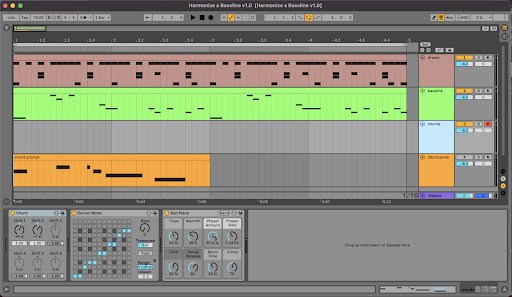Lesson 3: The Chord Device

Lesson overview
Take the mystery out of chord theory using Live’s MIDI devices to generate chords by playing single keys on a keyboard or controller. In this lesson, students learn how to generate chords using Live’s Chord device. They learn to make these chords fit in key with help from the Scale device. They then have a creative challenge to add a chordal accompaniment to a bassline.
Learning intentions
Critical listening – students learn to differentiate between a two-note interval, a three-note chord, and a four-note chord. They understand the difference between parallel chords and diatonic/modal chords.
Technology literacy – students use MIDI effects, to alter MIDI information.
- Creative/musical – students draw connections between chords’ musical construction and their conventional cultural associations in songs, film scores, game soundtracks, etc.
Preparation
Consider students’ skill level at recording melodic parts via MIDI, and select support resources as appropriate.
For the creative challenge: Have the Harmonize a Bassline Live Set downloaded and ready to open on each computer
Ensure a class playback system is available for students to share their work.
In the classroom
Step 1: Introduction – explain what a chord is and play some examples of chord progressions in various styles
Step 2: Practical introduction – have students use the Chord device to create some short progressions, with and without the Scale device
Step 3: Creative challenge – students use the Harmonize a Bassline Live Set to add chords to a short bassline via the Chord and Scale devices
- Step 4: Student sharing and feedback of work – students upload their files, play back their melodies, and give feedback to their peers

Introduction: Chords and the Chord device
A chord is three or more notes played at a time. In theory, any three notes can make a chord, but in practice, only certain combinations of notes will sound good. Chords can be complex but the Chord device enables you to create good-sounding harmony easily.
How deep do you want to go with chord theory? That’s up to you! For beginners, you may choose to have students load a Chord device* onto a track and get them to listen to what happens when you play MIDI notes while loading different presets.
To explain more deeply what chords are and how they work, refer to the Going Deeper resource. This explains the Chord device in detail, and gives the music theory background to its functionality.
*Note that the Chord device often sounds better if you add a Scale device after it. See the Going Deeper guide below for more details.
Going Deeper: The Chord Device
The Chord Device guide explains the device’s parameters, how to record its output as well as related music theory concepts including diatonicism vs parallelism, and how chords are constructed from different intervals.

Learning Foundation: Companion resources for the Chord device
Some students may need additional support in learning about chords and how to use them musically. These resources are listed in order from accessible to advanced.
The Chords section of the Learning Music website
Learning Music’s Chords section is an excellent companion resource to this project. Use the Export to Live option to move patterns created in the browser to Live.
Explore: Learning Music: Chords
ChordChord
ChordChord is a web app that generates four-chord loops and exports them as MIDI.
Explore: ChordChord
Making Chords from Scales
Making Chords from Scales is a blog post by the author of this classroom project, explaining chord/scale theory and the idea that every scale can become a chord if you rearrange its notes in a particular pattern. This theory is a useful way to understand many kinds of music and is the basis of jazz harmony.
Explore: Making chords from scales
The Chord Dictionary
The Chord Dictionary is a table of all the widely-used chords in Western music, showing their symbols, their associated scales, and the notes that make them up. It also comes with a series of videos explaining how they work.
Explore: The Chord Dictionary

Creative challenge: Harmonize a bassline
In this challenge, students play chords to accompany a bassline, using the Chord and Scale devices to ensure that the notes in their chords match the notes in the bassline.
The included Harmonize a Bassline Live Set includes a beat and a bassline. There is an empty MIDI track with a Chord device set to major triads and a Scale device set to Dorian mode.
The challenge is to create a four-bar chord progression over the bassline using this chord/scale combination. You can play any keys on the controller, and the Chord device will translate them into major triads. The Scale device will then fit the notes in the chords to C Dorian mode.
Challenge steps:
Students open the Harmonize a Bassline Live Set. It contains a beat, a bassline, and an empty track where they will create their own chords.
Students record a four-bar chord progression into the empty track. They can input any notes they wish; the Chord device will automatically generate chords, and the Scale device will filter the notes in the chords to fit within C Dorian mode.
If time permits, play each student’s melody for the class and ask for constructive feedback.
Harmonize a Bassline Challenge – Live Set
Download: Harmonize a Bassline – Live Set

The Harmonize a Bassline Live Set contains four tracks:
A drum machine beat
A bassline in C Dorian dominant mode
A blank electric piano track where students record their chord progression. Playing single notes will produce chords that match the bassline
A two-bar progression for students to use as a prompt for their chords – this track is muted, so students can unmute it if they want to hear it
